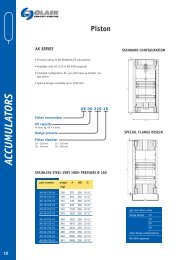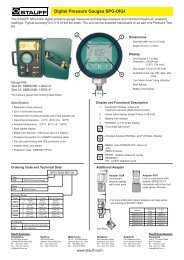Local Solutions for Individual Customers Worldwide - Oil Solutions
Local Solutions for Individual Customers Worldwide - Oil Solutions
Local Solutions for Individual Customers Worldwide - Oil Solutions
You also want an ePaper? Increase the reach of your titles
YUMPU automatically turns print PDFs into web optimized ePapers that Google loves.
Introduction<br />
Accumulators and Accessories<br />
Accumulators provide a means of regulating the per<strong>for</strong>mance of a hydraulic system. They are suitable <strong>for</strong> storing<br />
energy under pressure, absorbing hydraulic shock, dampening pump pulsation and fl ow fl uctuations. Bladder or<br />
diaphragm accumulators provide excellent gas and fl uid separation ensuring dependable per<strong>for</strong>mance, maximum<br />
effi ciency, and long service life.<br />
Why use an Accumulator?<br />
• Improves your system effi ciency • Accepted world wide<br />
• Supplements your pump fl ow • High/ low temperature tolerance<br />
• Supplies extra power in an emergency • Extremely safe (cannot be disassembled under pressure)<br />
• Compensates <strong>for</strong> any system leakage • Quick response<br />
• Absorbs hydraulic shocks • Wide range of compounds <strong>for</strong> a variety of fl uids<br />
Accumulator Function<br />
The design of the Stauff accumulator makes use of the difference in the compressibility between a gas (nitrogen) and<br />
a liquid (hydraulic fl uids). The bladder contained in the shell is pre-charged with nitrogen gas to a pressure determined<br />
by the system pressure.<br />
After pre-charging, the work can be split into three steps.<br />
Step 1. When the hydraulic fl uid enters the accumulator, the nitrogen contained in the bladder is compressed and<br />
its pressure is increased.<br />
Step 2. The compression of the bladder stops when the pressure of the fl uid and nitrogen are equal (balanced).<br />
During this step the bladder is not subject to any abnormal mechanical stress.<br />
Step 3. On demand, as system pressure falls, the accumulator’s stored fl uid is returned to the system under<br />
pressure applied by the compressed nitrogen. On completion of the hydraulic system functions, the<br />
accumulator reverts to step 1.<br />
3





